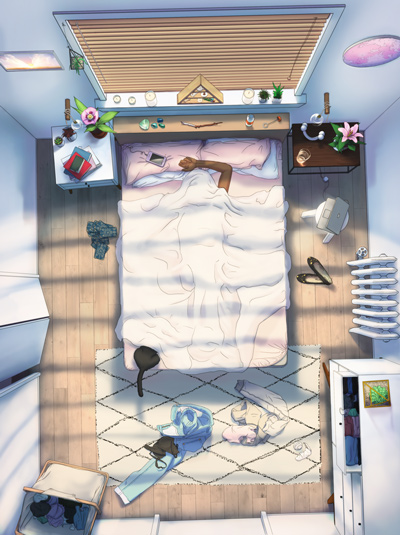

Stories hold power. What power do they hold in lane-pushing games?
In this article, we share how one of our ideas in the narrative space ripples out to inform other parts of our game, and makes a positive contribution to our broader community and vision.

During the summer, I came across an interview with Brie Code. She's the CEO of Tru Luv — the company behind a companion app called #SelfCare, and contributors to an enchanting upcoming game called Everwild.
Tru Luv creates game-like experiences using a different model for interaction design, focusing on care and connection. It has brought them an audience: their first app reached over 2M downloads.
In this interview, Brie speaks about their early development:
"What we were testing in that experience is, is it possible to create an experience that instead of using rising tension over time, which is the gamification model — a sense of growing challenge or growing danger, growing fear of missing out — can we create an experience of deepening connection and would people find that interesting?"
My attention is drawn to the relationship between challenge and deepening connection. Are these two things mutually exclusive? What is that relationship going to look like in our game?
Connection and Challenge
Of the two, the more familiar is challenge. Our genre glorifies challenge.
Rank identity, leaderboards, and highly competitive esports are tightly integrated with every commercial lane-pushing game. Any upcoming title holds similar aspirations.
At Kybolt, we appreciate challenge. At it's best we see players using it as a means to shared achievement and self-improvement.
As we've discussed in a previous article: our goal with Causeway is to get players' leadership skills working for them. We pose to our players the challenge of bringing out the best in the people around them: whether that takes humility, empathy, patience, or a great sense of humour!
Not everyone will embrace that challenge, and certainly not all of the time. But we want that invitation to be there, and to be real, and hope players come to value gaming in a community that celebrates positive leadership at every level of play.
Now, an observation:
"Leadership is a challenge of deepening connection."
It is a challenge of bringing players a little bit outside of the meta they are used to, and inviting them to participate in "this team" with its particular members and characteristics. It is a challenge to be open-minded, and flexible to participate in the shared creativity that can lead to memorable moments.
We want Causeway to be you finding yourself on a team that feels like a team.
And that isn't going to be easy.
Stress Responses
Thankfully, we aren't the first to think about deepening connection. Here's how Brie's team approached the experience that they were designing:
"We created a set of kind of mini games — we call them rituals — and instead of getting harder and harder as you play them, they follow different metaphors for deepening connection: things like going from messy to tidy, or awkward to smooth, or disconnected to connected instead of from easy to hard."
A key influence behind this approach was research on "stress responses": the instinctive biological ways that people respond to stress.
The most well-known is "fight or flight", where a person responds to threats by choosing to either fight or run away.
A more recently documented stress response is "tend and befriend", where a person responds to threats by joining social groups, caring for offspring, and contributing to networks. It makes evolutionary sense: the isolated sheep is easy prey!
Approximately half of people have a "tend and befriend" stress response (or "all of us, half of the time" according to Brie) — and plenty of games incorporate compatible ideas: such as building reputation among factions, or allowing players to take a break from the main challenge to help NPCs on side-quests.
The Way of the Genre
In lane-pushing games, "tend and befriend" has some presence in the mechanics: most prominently the support role. We also see the occasional character that expresses these ideas through their theme. Ivern is one of my favourite examples, and a wonderful innovation.
But the moment of truth is in those stressful moments: where the "tend and befriend" player's instinctive response is to reach out, help people, or try to find a mutually agreeable solution.
We feel the success rate of this approach lies far below where it should be. The genre at large leans towards "fight or flight"; towards muting and moving on.
It's a shame, because reaching out and finding consensus is a great "leader behaviour". That kind of teamwork and connected thinking is valuable in any game or community — where it can resolve potential negative situations, and accelerate positive opportunities.
That's value we recognise, and we want our players to experience more of it. Actually, we think Causeway should be the game in the genre to which people turn for this experience.
Immersive Stories
To invite a change in how players are behaving and the stories they're telling, we need to start with the stories we're telling.
My old game Rise of Winterchill followed a familiar lane-pushing narrative: a war of the highest stakes, with a cast of battle-hungry characters waiting to pick a fight. We had a great community; but at larger scale I have no doubt we would have had similar problems to other games.
Causeway has given us the opportunity to develop new ideas in lane-pushing narrative design. One of these is taking what works about "fight or flight", and adding "tend and befriend" metaphors to the mix — as an equally valid ingredient in how we design and present the game.
I'd like to share two examples of this from current Causeway development.
Farming to Nurturing
The first is that the universal narrative for jungle objectives is "beating up ogres and taking their money". It derives from Warcraft III, in turn drawn from countless older role-playing and fantasy games.
Causeway is exploring a different direction across the entire jungle: one where players clear out impurities and corruptions, and allow the natural wildlife in an area to resettle. In doing so, the wildlife may fetch an otherwise inaccessible reward for you, or assist your team for a while as companions.
Over time impurities will creep back in, and the cycle continues — but not without meaning. Wildlife might remember a player's efforts, and start to assist with future clearings.
Giving players the opportunity succeed by nurturing a relationship with their environment isn't just a change in theme. It invites us as designers to consider new game mechanics, and their implications.
Calming the Storm
A second example appears in the design of characters and their kits. One of the first characters we added to the game was Tempest: an old concept from Rise of Winterchill.
Tempest used to be a traditional "lightning mage" character, notable for a permanent grumpy stormcloud that follows him around zapping enemies.
In Causeway, our character design process is so different: drawing on human traits and characteristics in a way that informs kit and narrative design simultaneously. This framework is one of my favourite things to work with.
Last year we had a writer with us, and during their work on Tempest they told me: "the cloud attacking people has to change; it's not a fit for this character".
It took a while before we got to reviewing Tempest. Now the cloud doesn't passively zap people; it rains on them instead — and the connection between playing Tempest and guiding his cloud has grown stronger.
Tempest is also lower-violence than before: less 'slinging thunderbolts', and more 'patience, rhythm, and balance'. This resonates well with how we're representing a diverse range of leaders and characters in the game.
Future Direction
It will be a long road to deliver on our Design Principles! We see "tend and befriend" as one of the many concepts that has a role to play: whether it's informing game design, the client experience, or beyond.
We see that bringing in fresh ideas like these will lead to a product which is more fun, and can appeal in new ways for more players. Research on "tend and befriend" has shown that it's a stress response which is more prominent in women, and we absolutely want Causeway to be an experience that is welcoming for all genders.
We also hope involving "tend and befriend" will improve our ability to deliver on positive leadership: which really sits at the intersection between facing challenges and connecting with others. We believe both tenacity and empathy have a place in your team, and the more the storytelling of the game validates them: the more they will appear among players.
We'll continue development with an open mind and will see where it takes us. If what you've read reminds you of other ideas in this space, do let us know in the comments.
The Crafting Causeway series aims to introduce the features of Kybolt's upcoming game Causeway, while sharing insights about lane-pushing game design and encouraging discussion about how to improve the genre as a whole.
See more articles or leave a comment below.
- Log in to post comments
Comments
Cokemonkey11
The nurturing jungle example reminds me of SWAT: Aftermath, where you have to nurture the environment to make it more safe (destroy radiation fragments)